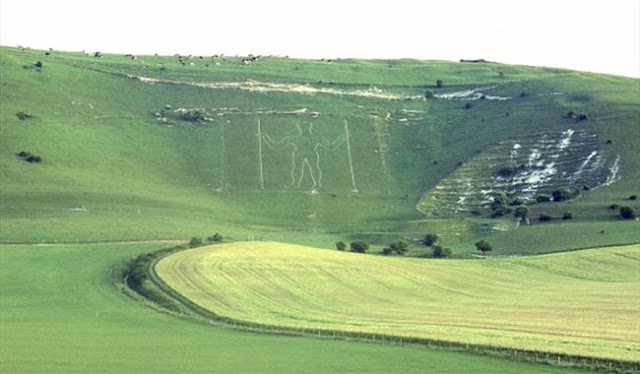When I was about 10 years old I went on a school trip which
remained in my memory long afterwards as a very enjoyable time even though I
couldn't remember much specific about it. I knew it was somewhere on the south
coast of England but had forgotten exactly where though I did remember the
highlight of the trip being an excursion in which we had walked across grassy
downs on a bright sunny day, blue sky above, birds singing in an English
morning, suddenly to discover at our feet a massive chalk figure carved into
the hillside. The teacher had wanted to surprise us and he did. I knew the
figure was of a man holding what appeared to be sticks in each hand, but it was
one of those indistinct childhood memories that have receded so far into the
past that they have become almost dreamlike. Nonetheless, the impression of
having encountered something otherworldly stuck with me and the sight of this
enigmatic figure awoke my imagination to the deep, ancient past
of this island.
Fast forward thirty odd years and I was living in the Sussex town of
Eastbourne. One day I was talking to someone who asked me if I'd seen the
nearby Long Man of Wilmington yet. I'd heard of it but not realised it was in
the vicinity. It turned out to be about 6 miles away so off I went to have a
look. There was the figure of my childhood.
This is how he appears when seen more or less from the road. He is
standing facing forwards though his feet are set sideways. He is depicted in
outline with no features which makes him appear more
archetypal than individual. It also gives him the air of mystery I noted when I
first saw him as a child, an air that his companion in Dorset, the Cerne Abbas
giant, does not have though that is for other reasons too. He conveys an
impression of watchfulness and seems almost like a guardian so it is no wonder
some people have speculated that he stands at the door of the underworld (not
hell but a spiritual realm beyond this earthly one), guarding the threshold from
unworthy intruders. The fact that he is positioned on the side of a hill
emphasises this even though that was undoubtedly more for reasons of display
since, as far as I am aware, all English chalk figures are on hillsides, making
them visible to more than the birds. But still, this gives the impression of a
gateway into somewhere beyond this mortal world.
What are those things in his hands? Are they sticks or staves, symbols of his office perhaps or the remains of what were once agricultural tools, or are they the sides of a doorway, the gate he guards as he blocks the entrance to the next world with power and authority for he does indeed embody those qualities, his muscular frame and bold stance telling us that, if we are not entitled to pass, we shall not pass.
The Long Man is 235 feet tall which makes him the largest representation of the human figure in Europe. It was once assumed that he came from the Neolithic or Iron Age (there is a long barrow nearby), probably representing a pagan deity, but it turns out that there is no documentary evidence for him from before the 18th century, and the general consensus now is that he goes back no further than the 16th or 17th centuries. But if he does who or what is he supposed to be? He used to be known as the Green Man because that was how he appeared before a 19th century restoration embedded chalk into his outline, for though he is carved into a chalk hill, the soil on top of the chalk is relatively deep. This name, of course, also links him with the old pagan religion.
Maybe he is no more than a few hundred years old, but he surely reaches
back to something much earlier. For me, the idea of him as some kind of
guardian of the land makes the most intuitive sense since, even if this was not his
original role, it is what he has become. I am tempted to speculate that he might even
be a representation of Albion himself, a giant carved in the white earth on the
southern shores of England protecting the land from invaders, but also welcoming
people as he stands at the entrance to England. My feeling when I first saw him
as a child was he did have something sacred about him, something that is linked
to the land of which he is a part. Could it be that he was always there on the
ground but sleeping until the 16th or 17th century when he was not created so
much as woken up? This time period does, after all, coincide with the rise of British power,
albeit material not spiritual power. Perhaps this means he is still only half
awake (the lack of facial features supporting this idea) and we await his true
rising.
If you are looking for a depiction of Albion, here is one as good as any.





